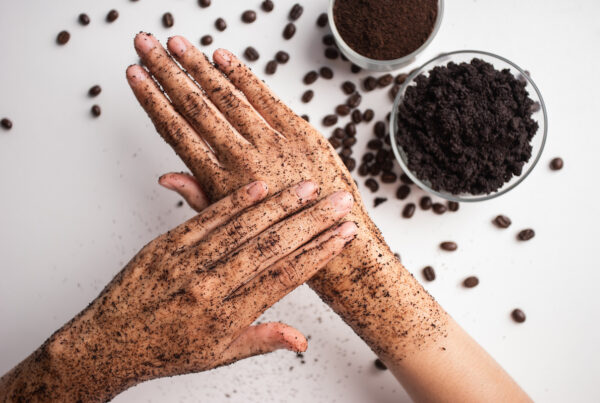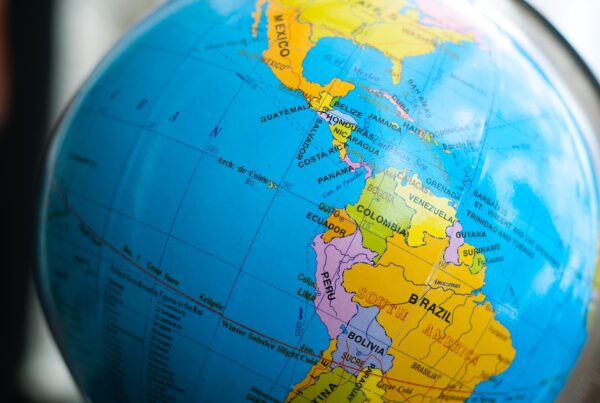So where does the coffee we drink actually come from?
Premium Colombian coffee makes a long journey before eventually reaching our cups. It begins as a seed, which grows into a plant, which produces a fruit, which contains more seeds. Those seeds are what we consume (a.k.a. coffee “beans”).
Flowering branches of coffee plants produce a type of stone fruit, generally referred to as coffee “cherries.” Each coffee cherry typically contains two adjacent seeds in the center, although there is a small percentage that only contain one larger “peaberry” if one of the seeds does not get fertilized during its natural growth process.
Once they are at their peak ripeness, the coffee cherries are collected by the farmers to prepare for processing. The seeds are removed from the skin and pulp of the fruit, and dried.
This raw or “green” coffee is then exported, roasted, ground, brewed, and enjoyed.
Let’s now take a closer look at each step.
Coffee’s journey step-by-step:
Planting:
Coffee seeds are typically planted in large beds in shaded nurseries. They remain there until the plants are strong enough to be transferred and permanently planted into the ground.
Harvesting:
A coffee plant takes on average three to five years to produce its first fruit. Coffee cherries will grow along the branches and change in color during their maturation. They start off green and eventually turn bright and generally red, indicating they are ripe and ready to be collected.
Processing and drying:
The goal of processing coffee is to separate the bean from the coffee cherry. This stage is extremely important as bad coffee processing can lead to defects which decrease the flavor, quality and value of the coffee. There are different methods to process coffee according to location and local resources. These are the most common ones:
-
The Dry or “Natural” process
is the oldest method of processing coffee and is the only option in some regions where water is limited. After the coffee cherries are picked, they are spread out to dry on flat surfaces like brick patios or raised tables. To avoid spoilage, the cherries are turned regularly during the day and covered at night or during rainy weather. This process usually continues for several weeks. Once the cherries are properly dry, the skin is removed mechanically. Common flavor notes for natural processed coffees include blueberry, strawberry, tropical fruits, honey and red wine.
-
The Wet or “Fully Washed” process
is becoming very popular and is the most common method in Colombia. In this process all of the fruit flesh is removed from the coffee beans with a machine called a depulper before the beans are dried. After depulping, the beans are put into a water tank where fermentation will remove the remainder of the fruit pulp. Fermentation usually requires 24-72 hours depending on the climate and altitude. Once fermentation is complete, the coffee beans are washed to remove any leftover skin and are ready to be dried. Drying in the washed process is also done on brick patios or raised beds. To ensure even drying, the beans are turned regularly. Many describe washed coffees as being cleaner and more representative of the pure flavor traits within the bean in comparison to natural coffees, with notes of white wine.
-
The Semi Washed process:
The outer skin of the coffee cherry is removed but the mucilage – next layer after the skin – remains on the parchment and is sun-dried. Then the parchment layer is removed. The white beans enter the second drying phase. This processing method increases the coffee’s body and intensity and is commonly found in Brazilian and Indonesian coffees.
-
The Pulped Natural or “Honey” process:
This process is mostly used in Central America. The cherries are mechanically de-pulped intentionally leaving a specific amount of skin on the beans. The beans then go straight to the drying tables or patios to dry. The honey process is designed to increase overall sweetness and body in the cup thanks to the sugars from the remaining fruit skin. The risk of over-fermentation is lower in comparison to the natural process since there is less flesh left on the beans.
Milling:
Before export, the beans are put through hulling machines to remove the parchment layer. The beans are then graded and sorted by size and weight. Finally, all defective beans (unacceptable size or color, over-fermented, insect-damaged, or un-hulled) are removed. In many countries, this process is done both by machine and by hand, ensuring that only the finest quality coffee beans are exported.
Exporting:
The milled beans, referred to as green coffee, are packed in either jute or sisal bags and shipped in containers. *According to the National Coffee Federation, Colombia exported 12.5 million 60-kg bags of green coffee in 2020.
Tasting or “Cupping”:
Coffee is repeatedly tested for quality and taste. Green coffee beans are first evaluated by their overall visual quality. The beans are then roasted and tasted (this is known as “cupping”) to determine their characteristics and flaws, as well as for the purpose of creating different blends or creating the proper roast profile.
Roasting:
Heating for several minutes in a controlled environment transforms green coffee into the aromatic brown and flavorful beans that are ready for consumption. Most roasting machines maintain a temperature of about 550 degrees Fahrenheit. The beans are kept moving throughout the entire process to keep them from burning until they begin to turn brown and a fragrant oil locked inside the beans begins to emerge. After roasting, the beans are immediately cooled either by air or water. Roasting is generally performed in the importing countries because freshly roasted beans must reach the consumer as quickly as possible.
Grinding:
The objective of a proper grind is to get the most flavor in a cup of coffee. Coffee must be ground coarse or fine depending on the brewing method. The length of time the grounds will be in contact with water determines the ideal coarseness (size of the grind particles). Basically the finer the grind, the more quickly the coffee should be prepared. That’s why coffee grounds for an espresso machine are much finer than coffee brewed in a slow drip coffee maker.
Brewing:
There are many ways to brew coffee and it really all comes down to preference. Popular methods include French Press, Drip, Pour Over, Espresso, Cold Brew and Syphon.
Every step is important
As we have learned, coffee goes through many steps before reaching our cups. It is a fascinating process that sometimes gets overlooked. The fact is it requires a great deal of work and a large amount of care from many professionals along the way. Each step is essential in bringing out the very best from our coffee beans.








